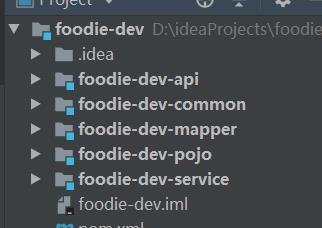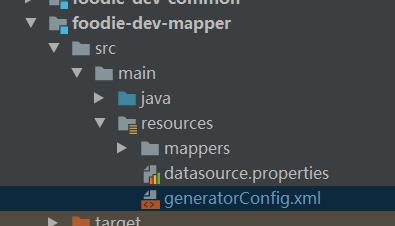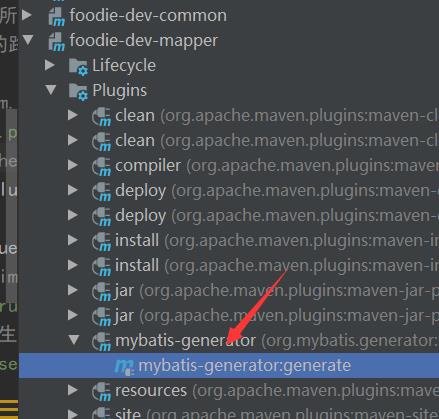在Java聚合工程里使用mybatis-generator
Posted zhaobao1830
tags:
篇首语:本文由小常识网(cha138.com)小编为大家整理,主要介绍了在Java聚合工程里使用mybatis-generator相关的知识,希望对你有一定的参考价值。
参考地址:
使用maven构建的Java聚合工程,结构如下:

使用mybatis-generator可以创建pojo、mapper,所以我们把配置文件放在foodie-dev-mapper的文件夹下
1、先进行pom.xml的配置,引入mybatis-generator的相关jar包
<!-- 下面这些就是用来配置mybatis.generator-->
<build>
<finalName>foodie-dev-mapper</finalName>
<pluginManagement><!-- lock down plugins versions to avoid using Maven defaults (may be moved to parent pom) -->
<plugins>
<!-- geelynote maven的核心插件之-complier插件默认只支持编译Java 1.4,因此需要加上支持高版本jre的配置,在pom.xml里面加上 增加编译插件 -->
<plugin>
<groupId>org.apache.maven.plugins</groupId>
<artifactId>maven-compiler-plugin</artifactId>
<configuration>
<source>1.8</source>
<target>1.8</target>
<encoding>UTF-8</encoding>
<!--之后把支付宝的jar包放到这个位置,这样我们在变异的时候,就可以吧jart包引入;
不然的话,本地可以,但是发布以后,发现缺少jar包-->
<compilerArguments>
<extdirs>${project.basedir}/src/main/webapp/WEB-INF/lib</extdirs>
</compilerArguments>
</configuration>
</plugin>
<plugin>
<artifactId>maven-clean-plugin</artifactId>
<version>3.1.0</version>
</plugin>
<!-- see http://maven.apache.org/ref/current/maven-core/default-bindings.html#Plugin_bindings_for_war_packaging -->
<plugin>
<artifactId>maven-resources-plugin</artifactId>
<version>3.0.2</version>
</plugin>
<plugin>
<artifactId>maven-compiler-plugin</artifactId>
<version>3.8.0</version>
</plugin>
<plugin>
<artifactId>maven-surefire-plugin</artifactId>
<version>2.22.1</version>
</plugin>
<plugin>
<artifactId>maven-war-plugin</artifactId>
<version>3.2.2</version>
</plugin>
<plugin>
<artifactId>maven-install-plugin</artifactId>
<version>2.5.2</version>
</plugin>
<plugin>
<artifactId>maven-deploy-plugin</artifactId>
<version>2.8.2</version>
</plugin>
</plugins>
</pluginManagement>
<plugins>
<!--根据数据库的数据结构,配置的表结构,去生成我们对于的dao层文件-->
<plugin>
<groupId>org.mybatis.generator</groupId>
<artifactId>mybatis-generator-maven-plugin</artifactId>
<version>1.3.2</version>
<configuration>
<verbose>true</verbose>
<overwrite>true</overwrite>
</configuration>
</plugin>
</plugins>
</build>
2、进行generatorConfig.xml的配置,这是mybatis-generator的配置文件

<?xml version="1.0" encoding="UTF-8"?> <!DOCTYPE generatorConfiguration PUBLIC "-//mybatis.org//DTD MyBatis Generator Configuration 1.0//EN" "http://mybatis.org/dtd/mybatis-generator-config_1_0.dtd"> <!-- 这个配置文件是给mybatis-generator使用的 --> <generatorConfiguration> <!--导入属性配置--> <properties resource="datasource.properties"></properties> <!--指定特定数据库的jdbc驱动jar包的位置--> <classPathEntry location="${db.driverLocation}"/> <context id="default" targetRuntime="MyBatis3"> <!-- optional,旨在创建class时,对注释进行控制 --> <commentGenerator> <property name="suppressDate" value="true"/> <property name="suppressAllComments" value="true"/> </commentGenerator> <!--jdbc的数据库连接 --> <jdbcConnection driverClass="${db.driverClassName}" connectionURL="${db.url}" userId="${db.username}" password="${db.password}"> </jdbcConnection> <!-- 非必需,类型处理器,在数据库类型和java类型之间的转换控制--> <javaTypeResolver> <property name="forceBigDecimals" value="false"/> </javaTypeResolver> <!-- Model模型生成器,用来生成含有主键key的类,记录类 以及查询Example类 targetPackage 指定生成的model生成所在的包名 targetProject 指定在该项目下所在的路径 --> <!--<javaModelGenerator targetPackage="com.mmall.pojo" targetProject=".\\src\\main\\java">--> <javaModelGenerator targetPackage="com.zb.pojo" targetProject="./src/main/java"> <!-- 是否允许子包,即targetPackage.schemaName.tableName --> <property name="enableSubPackages" value="false"/> <!-- 是否对model添加 构造函数 --> <property name="constructorBased" value="true"/> <!-- 是否对类CHAR类型的列的数据进行trim操作 --> <property name="trimStrings" value="true"/> <!-- 建立的Model对象是否 不可改变 即生成的Model对象不会有 setter方法,只有构造方法 --> <property name="immutable" value="false"/> </javaModelGenerator> <!--mapper映射文件生成所在的目录 为每一个数据库的表生成对应的SqlMap文件 --> <!--<sqlMapGenerator targetPackage="mappers" targetProject=".\\src\\main\\resources">--> <sqlMapGenerator targetPackage="mappers" targetProject="./src/main/resources"> <property name="enableSubPackages" value="false"/> </sqlMapGenerator> <!-- targetPackage:mapper接口dao生成的位置 --> <!--<javaClientGenerator type="XMLMAPPER" targetPackage="com.mmall.dao" targetProject=".\\src\\main\\java">--> <javaClientGenerator type="XMLMAPPER" targetPackage="com.zb.dao" targetProject="./src/main/java"> <!-- enableSubPackages:是否让schema作为包的后缀 --> <property name="enableSubPackages" value="false" /> </javaClientGenerator> <!-- 这是用来配置数据库文件和生成的文件--> <!-- tableName是数据库里的表名--> <!-- domainObjectName是我们生成的pojo的名字--> <table tableName="stu" domainObjectName="Stu" enableCountByExample="false" enableUpdateByExample="false" enableDeleteByExample="false" enableSelectByExample="false" selectByExampleQueryId="false"></table> <table tableName="carousel" domainObjectName="Carousel" enableCountByExample="false" enableUpdateByExample="false" enableDeleteByExample="false" enableSelectByExample="false" selectByExampleQueryId="false"></table> <table tableName="category" domainObjectName="Category" enableCountByExample="false" enableUpdateByExample="false" enableDeleteByExample="false" enableSelectByExample="false" selectByExampleQueryId="false"></table> <table tableName="items" domainObjectName="Items" enableCountByExample="false" enableUpdateByExample="false" enableDeleteByExample="false" enableSelectByExample="false" selectByExampleQueryId="false"></table> <table tableName="items_comments" domainObjectName="ItemsComments" enableCountByExample="false" enableUpdateByExample="false" enableDeleteByExample="false" enableSelectByExample="false" selectByExampleQueryId="false"></table> <table tableName="items_img" domainObjectName="ItemsImg" enableCountByExample="false" enableUpdateByExample="false" enableDeleteByExample="false" enableSelectByExample="false" selectByExampleQueryId="false"></table> <table tableName="items_param" domainObjectName="ItemsParam" enableCountByExample="false" enableUpdateByExample="false" enableDeleteByExample="false" enableSelectByExample="false" selectByExampleQueryId="false"></table> <table tableName="items_spec" domainObjectName="ItemsSpec" enableCountByExample="false" enableUpdateByExample="false" enableDeleteByExample="false" enableSelectByExample="false" selectByExampleQueryId="false"></table> <table tableName="order_items" domainObjectName="OrderItems" enableCountByExample="false" enableUpdateByExample="false" enableDeleteByExample="false" enableSelectByExample="false" selectByExampleQueryId="false"></table> <table tableName="order_status" domainObjectName="OrderStatus" enableCountByExample="false" enableUpdateByExample="false" enableDeleteByExample="false" enableSelectByExample="false" selectByExampleQueryId="false"></table> <table tableName="orders" domainObjectName="Orders" enableCountByExample="false" enableUpdateByExample="false" enableDeleteByExample="false" enableSelectByExample="false" selectByExampleQueryId="false"></table> <table tableName="user_address" domainObjectName="UserAddress" enableCountByExample="false" enableUpdateByExample="false" enableDeleteByExample="false" enableSelectByExample="false" selectByExampleQueryId="false"></table> <table tableName="users" domainObjectName="Users" enableCountByExample="false" enableUpdateByExample="false" enableDeleteByExample="false" enableSelectByExample="false" selectByExampleQueryId="false"></table> <!-- geelynote mybatis插件的搭建 --> </context> </generatorConfiguration>
备注:
文件夹名一定要和配置文件里一致
3、点击右侧maven的工具生成代码

4、要在聚合工程中使用生成的文件,还需要在application.yml中对mybaitis进行配置
mybatis: mapper-locations: classpath*:mappers/*.xml
这个是必须的,不然会出现mapper和xml不匹配的操作
以上是关于在Java聚合工程里使用mybatis-generator的主要内容,如果未能解决你的问题,请参考以下文章